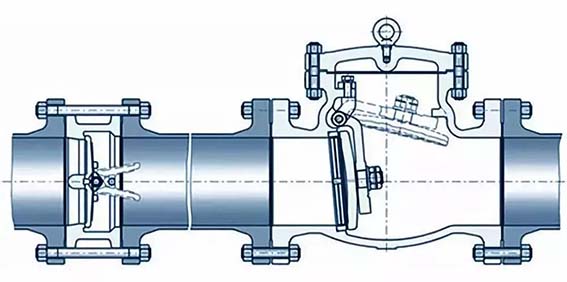The purpose of using a check valve is to prevent reverse flow of the medium, and a check valve is generally installed at the outlet of the pump. In addition, a check valve should also be installed at the outlet of the compressor. In short, in order to prevent reverse flow of the medium, check valves should be installed on equipment, devices, or pipelines.
Generally, vertical lift check valves are used on horizontal pipelines with a nominal diameter of 50mm. The straight lift check valve can be installed on both horizontal and vertical pipelines. The bottom valve is generally only installed on the vertical pipeline at the pump inlet, and the medium flows from bottom to top.
The swing check valve can be made with a high working pressure, with a PN of up to 42MPa, and a DN of up to 2000mm. According to the different materials of the shell and sealing components, it can be suitable for any working medium and any working temperature range. The medium is water, steam, gas, corrosive medium, oil, food, medicine, etc. The working temperature range of the medium is between -196~800 ℃.
The installation position of swing check valves is not limited and is usually installed on horizontal pipelines, but they can also be installed on vertical or inclined pipelines.
The
butterfly check valve is suitable for low pressure and large caliber applications, and its installation is limited. Because the working pressure of butterfly check valves cannot be very high, but the nominal diameter can be large, reaching over 2000mm, but the nominal pressure is all below 6.4MPa. Butterfly check valves can be made into a wafer type, usually installed between the two flanges of the pipeline, using a wafer connection form.
The installation position of butterfly check valves is not limited and can be installed on horizontal pipelines, vertical pipelines or inclined pipelines.
Diaphragm type check valves are suitable for pipelines that are prone to water hammer. Diaphragms can effectively eliminate water hammer caused by reverse flow of media. Due to the limitations of the diaphragm material on the working temperature and pressure of the diaphragm check valve, it is generally used in low-pressure and normal temperature pipelines, especially suitable for tap water pipelines. Generally, the working temperature of the medium is between -20~120 ℃, and the working pressure is less than 1.6MPa. However, the diaphragm check valve can achieve a larger diameter, with a maximum DN of over 2000mm.
Diaphragm check valves have been widely used in recent years due to their excellent waterproof performance, simple structure, and low manufacturing cost.
The spherical check valve has good sealing performance, reliable operation, and good water hammer resistance due to its rubber coated sealing element; Due to the fact that the sealing element can be either a single ball or multiple balls, it can be made into a large diameter. But its sealing element is a hollow sphere wrapped in rubber, which is not suitable for high-pressure pipelines, only suitable for medium and low pressure pipelines.
Due to the fact that the shell material of the spherical check valve can be made of stainless steel, and the hollow sphere of the sealing element can be coated with polytetrafluoroethylene engineering plastic, it can also be applied in pipelines with general corrosive media.
The working temperature of this type of check valve is between -101~150 ℃, its nominal pressure is ≤ 4.0MPa, and its nominal diameter range is between 200~1200mm.


评论
发表评论